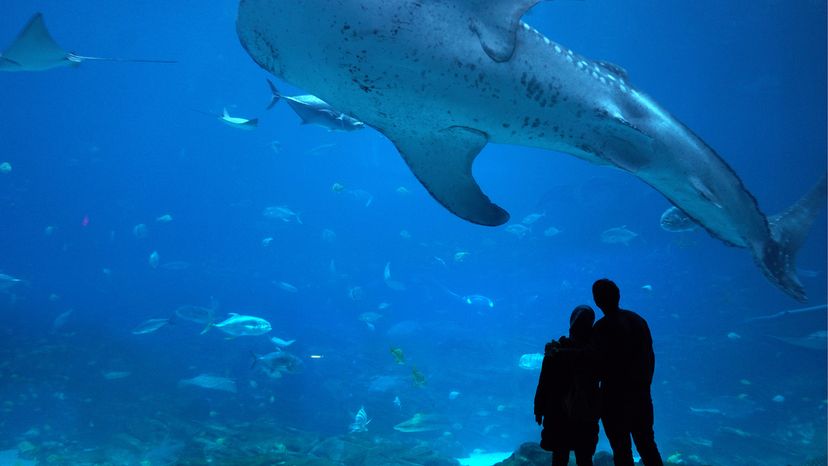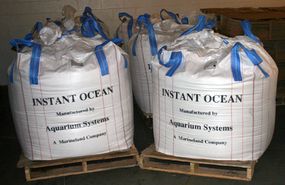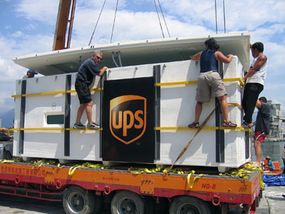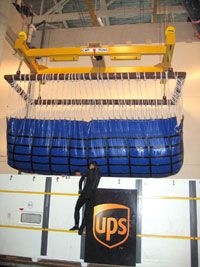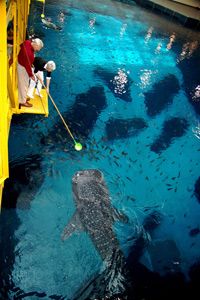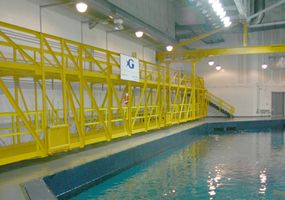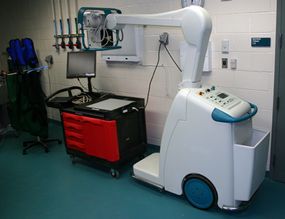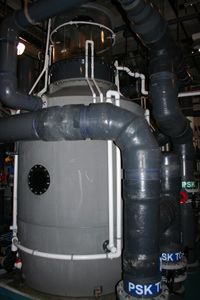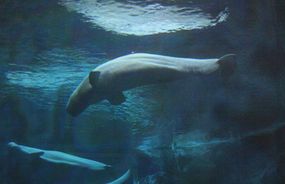A couple observes a giant whale shark in Georgia Aquarium, the largest aquarium in the United States. ferita Rahayuningsih / Shutterstock
Georgia Aquarium is the biggest aquarium in the U.S., whether you measure by the number of fish (more than 100,000) or the volume of water (more than a million cubic feet). It houses about 500 species in 60 habitats with 12,000 square feet of viewing windows, and it cost $290 million to build.
Thank You!
HowStuffWorks would like to thank the staff of the Georgia Aquarium for their assistance with this article. Special thanks to assistant veterinarian Megan Blasier, senior biologist Gina Fisher, senior life support operator Eric Hall, water chemist Anne Prusak, public relations director David Santucci, biologist Erika Stuebing and laboratory technician Jennifer Talarski.
Building the Aquarium
Building the aquarium, a parking deck and exhibits for all these animals was no small task. In the process, the aquarium used:
328 tons (297.6 metric tons) of acrylic windows, about the weight of two fully-grown blue whales290 plumbing fixtures, 200 floor drains and 53 roof drains connected with 1.5 miles (2.4 km) of underground pipe and 5.5 miles (8.9 km) of aboveground pipe61 miles (98.1 km) of pipe and wire100,000 yards (91.4 km) of concrete and 2,500 auger-cast piles
A skylight over the Ocean Voyager tank lets the fish get natural sunlight on clear days. In this picture, the skylight’s louvers are closed.
The Ocean Voyager tank, the largest habitat, holds three-fourths of the aquarium’s water. It is 263 feet long by 126 feet (38.4 meters) wide by 33 feet (10.1 meters) deep, and it holds 6 million gallons (22.7 million liters) of water.
Pens at one end allow staff to separate fish from the rest of the tank, and veterinarians can examine larger animals inside them. A slow-moving conveyor belt takes visitors through a 100-foot (30.5-meter) acrylic tunnel under the tank, letting them view the fish from below.
Other aquarium exhibits include the 800,000-gallon (3-million-liter) beluga whale enclosure, smaller tanks and multiple touch tanks where visitors can get hands-on experience with aquatic animals.
Many of the tanks use artificial light, but the Ocean Voyager tank, the beluga whale habitat and the large coral reef all receive natural light.
To salinate the water for the marine exhibits, the Aquarium used 1.5 million pounds (680,389 kg) of Instant Ocean® sea salt. Keeping the water salinated requires very little additional salt.
The aquarium piped in 8 million gallons (30.3 million liters) of ordinary tap water — enough to fill 160,000 bathtubs — to fill the tanks. After treating it to remove chemicals and impurities, the staff had to turn this fresh water into salt water for marine habitats.
To do this, they added 750 2,000-pound sacks of Instant Ocean® sea salt, for a total of 1.5 million pounds (680,389 kg). That’s the equivalent of more than 920,000 containers of table salt.
Acquiring Animals
Like all zoos and aquariums, the Georgia Aquarium has received criticism from animal rights groups and others who believe that the animals living there would be better off in the wild.
However, about 70 percent of the aquarium’s animals came from fish farms, zoos and other aquariums. In several cases, aquarium staff rescued animals living in unhealthy circumstances, or that would have died without their intervention.
With the help of United Parcel Service (UPS), the aquarium staff moved more than 100,000 fish from aquaculture farms in Taiwan to a quarantine warehouse in a period of 36 hours. These fish flew in 42 specially designed tanks, and many of them were very small when they arrived.
Some of the aquarium’s largest species also arrived via UPS. For example, Ralph and Norton, the aquarium’s original whale sharks, and beluga whales Nico and Gasper made their journeys in specially designed tanks with life support systems.
Ralph and Norton flew 8,000 miles (12,875 km) from Taipei, Taiwan, with a layover in Anchorage, Alaska, on a specially equipped B-747 freighter jet. Nico and Gasper flew 1,331 miles (2,142 km) from Mexico City, Mexico, on a 767 cargo jet.
Aquarium staff accompanied the animals on their journeys and moved them into and out of their containers using special slings. Flatbed trucks carried the enclosures from Hartsfield-Jackson International Airport to the aquarium.
Aquarium specialists secure a whale shark in its transport container off the coast of Taiwan. Whale sharks are the largest known fish in the world, but these are still juveniles.
Photo courtesy UPS
With animals and water inside, the whale shark tank weighed 54,000 pounds (24,494 kg), and the whale tank weighed 26,000 pounds (11,793 kg). Because of all this weight, the airplanes required modifications to handle the load.
UPS workers had to place the tanks precisely according to the planes’ center of gravity. The weight also affected takeoff and landing speeds.
A specialized sling removes a whale shark from its transport container.
Photo courtesy UPS
In addition to the whales, whale sharks and animals from aquaculture facilities, other live animals brought to the aquarium include:
A school of tarpon, silver fish that can weigh more than 300 pounds (136.1 kg) when fully grown, rescued from a tide poolSeveral species of tropical fish rescued after the U.S. Fish and Wildlife Service confiscated them as an illegal shipmentA bowmouth guitarfish caught by accident by Taiwanese fishermenOz and Gracie, sea otters from the Oregon Zoo and California’s Aquarium of the PacificLocal species, like cownose rays, collected from the Georgia coastCoral, grown for use in the aquarium rather than harvested from existing reefs
Feeding the Animals
Feeding the animals at the Georgia Aquarium is much more complex than just sprinkling food on the water’s surface.
The aquarium staff prepares meals for all its animals in the husbandry commissary, a specially designed kitchen held to higher standards than restaurant kitchens. The United States Department of Agriculture conducts random inspections of the commissary to ensure it is sanitary.
The husbandry commissary has a freezer that holds 20,000 pounds (9,071.9 kg) of food and a refrigerator that holds 6,000 pounds (2,721.6 kg). The aquarium staff prepares food for the animals every day.
Animal diets, amounts of food and the number of daily feedings vary widely from species to species. Some of the animals eat prepared food that resembles what they eat out of captivity, and others eat exactly what they eat in the wild. Many get vitamins or medicines in their food.
Bernie and Billi Marcus feed a whale shark.
Photo and video courtesy Georgia Aquarium
For example:
Leafy sea dragons eat exactly what they eat in the ocean — small shrimp called mysids.Whale sharks eat a special, premade gel food and tiny crustaceans called krill. Whale sharks are filter-feeding fish, and they learned to eat from scoops before traveling to the aquarium.Beluga whales get four feedings of fish per day, and the largest eats about fifty pounds of fish divided among those four feedings.Sea otters eat food-grade fish and clams. The biologists who work with the otters inspect their food for scrapes and cuts where bacteria can grow.
Aquarium specialists have access to the tanks to feed the animals, but the vast Ocean Voyager tank presents unique challenges. It’s roughly the shape of an hourglass and houses a wide variety of fish.
Along with the whale sharks are great hammerhead sharks, sawfish, bowmouth guitarfish, grouper and golden trevally. To feed all these fish, the aquarium uses a gantry crane, which runs on rails over the entire width of the tank.
They set up feeding stations for each animal on the crane’s platform. These stations let the staff make sure each animal gets the right amount of the right kind of food. As long as they receive enough food, even the most predatory species won’t typically feed on smaller fish.
This gantry crane lets the Aquarium staff set up feeding stations for each fish species in Ocean Voyager.
Feeding the fish high-quality food, customized based on what they eat in the wild and need to thrive in captivity, helps to keep them healthy.
Animal Health
The Georgia Aquarium’s veterinary services and conservation medicine facility is like a teaching hospital where doctors get hands-on experience working with patients. It’s a 5,800-square-foot (538.8-square-meter) unit with 15 staff members, and it houses 26 treatment tanks and a fully equipped surgery.
The aquarium partners with the University of Georgia and provides internships to train new aquatic animal specialists. The veterinary staff also researches animal health and behavior and shares their results with other zoos and aquariums.
The laboratory and health facility can run blood tests, examine slides under a microscope and culture bacteria for analysis.
A mobile, digital radiography system in the aquarium’s surgery. The x-ray emitter sends a signal to the plate, which sends an image to the screen.
The surgery department also has a mobile, digital radiography unit that can move anywhere in the facility and can x-ray animals as small as penguins and large as whales. It has an ultrasound machine, an endoscope and machines that allow mammals, reptiles and fish to be anesthetized for surgery.
Preventive medicine is relatively new to the aquarium industry, but the Georgia Aquarium is working on preventive medicine protocols for all of its larger animals, including annual exams. Some animals, like beluga whales, which are prone to ulcers and swallowing foreign objects, receive routine endoscopies.
Some animals may receive vaccines, although preventive medicine for aquarium fish generally relies on observation and quarantines for all new animals rather than vaccines.
All of the larger animals in the aquarium learn husbandry behaviors, which makes it easier for veterinary staff to conduct examinations.
For example, when a trainer instructs them to, whales will present their flippers or tail flukes for examinations or blood collection. They will also blow from their blowhole onto a plate, which staff can examine under a microscope for parasites and bacteria.
When held, penguins will present their feet for foot checks. This makes it easier for the staff to do their work and considerably reduces stress on the animals.
Fish Life Support
Even though the Georgia Aquarium’s tanks hold 8 million gallons (30.3 million liters) of water, the facility uses only as much water as an average supermarket. A treatment and reclamation system cleans and recycles the water, losing only a little to evaporation and the protein skimmers that help remove debris.
Behind the scenes, the aquarium uses three types of filtration:
Mechanical filtration: removes fine particulatesFractionation: removes dissolved organic materialsOzone: plays the same role as chlorine in a swimming pool but is safer for fish
It takes 218 pumps, 141 sand filters and 70 protein skimmers to filter the whole aquarium. These pumps move 261,000 gallons (987,992.5 liters) of water per minute — equal to about 163,125 toilet flushes.
Ocean Voyager alone requires 28 pumps and 56 sand filters, which clean about 1,800 gallons (6,813.7 liters) of water per minute. The life support staff must perform maintenance, including oil changes and filter changes, on all of these pumps and filters.
This pump drives a protein skimmer.
The life support staff also measures tank turnover time — the amount of time it takes for all the water in a tank to be filtered and cleaned. The staff’s goal is to keep the turnover time under two hours.
Flow rates also affect the dissolved oxygen in the tanks; the fish will suffocate if there is too little, but too much can be toxic.
All these pumps send water through a series of filters and skimmers. Even though this process is necessary, it can also create some problems.
Filters and Skimmers
Sand Filters
The sand filters are similar to what you would find in a home swimming pool, but on a much larger scale. The pumps force water through the sand at 15 to 20 psi and the sand traps debris. The system can automatically back-wash sluggish filters, and the staff changes the sand periodically.
Protein Skimmers
The protein skimmer produces foam. Debris clings to this foam, and when the foam overflows it takes the debris with it.
In a protein skimmer, water from the exhibits passes through the filter, which injects air at a very high velocity. A venturi valve — a tube with a constricted area in the center — breaks the air into microbubbles.
These bubbles have a lot of surface area for debris to cling to. The foam this process creates overflows from an opening at the top of the filter and falls into a collection chamber, which the staff must clean periodically.
This process naturally requires a lot of pumping, which can produce dissolved gasses harmful to fish. So, the system pumps water up into holding tanks above the exhibits and allows the dissolved gasses to dissipate. Then, gravity pulls the water back into the habitats.
Heating or cooling a small amount of water before returning it to the exhibits helps keep them at the correct temperature.
Automated Systems With a Manual Touch
This system sounds complex, but a computer handles nearly all the decisions regarding clean and dirty water.
Eleven computers connected throughout the building make 150 million decisions per second involving tank levels, temperatures and pumping flow. The computer uses graphics and data to provide information and feedback to the life support staff.
Even though the system is almost 100 percent self-sustaining, the staff still takes samples from every exhibit daily, analyzes them in a lab, and adds any necessary chemicals by hand.
The high-performance liquid chromatography (HPLC) system can measure antibiotic concentrations and anything abnormal in the water. The laboratory staff use it for research.
Water chemists evaluate the nitrogen cycle — the breakdown of organic material into nitrogenous wastes — and ammonia levels, pH, salinity and oxygen in water samples from every habitat daily.
An ion photography system measures, dilutes and analyzes samples, recording anything that is positively or negatively charged. The staff also uses a high-performance liquid chromatography (HPLC) system for research-based applications.
Education and the 4R Program
It’s hard to miss the educational focus when you visit the aquarium. Every exhibit has signs or touch screens with information about its inhabitants. The aquarium also has education stations to offer additional information to the public.
Touch tanks, staffed with employees and volunteers, allow people to touch and interact with the aquarium’s animals. In several areas, projectors display information about the animals along walls and floors.
The aquarium also offers behind-the-scenes tours where visitors can see how the aquarium feeds and cares for fish.
A beluga whale in the 800,000-gallon (30.3-million-liter) whale habitat. Beluga whales live exclusively in arctic and subarctic waters, so the water in their tank is always 55 degrees Fahrenheit (13 degrees Celsius).
The aquarium’s 4R program is another avenue for research, conservation and improving fish life in captivity and the wild. The four Rs are rehabilitation, relocation, rescue and research.
Donations to the program support actions like the rescue of Nico and Gasper and their relocation to Georgia. In that case, three donors pledged $50,000 each, contingent upon a dollar-for-dollar match from the community, to rescue and relocate the animals.
Funding and Running the Aquarium
The Georgia Aquarium started with The Home Depot founder Bernie Marcus. Marcus wanted to present a gift to the city of Atlanta and the state of Georgia that would encourage education and economic growth.
In November 2001, he announced his plan to build an aquarium in downtown Atlanta. He and his wife Billi donated $250 million toward the Georgia Aquarium’s construction.
But they didn’t do it alone. Marcus and aquarium staff visited 56 aquariums in 13 countries to research and gather ideas. They also received financial contributions from AirTran Airways, BellSouth, Georgia-Pacific, The Home Depot, Southern Company and SunTrust Bank, which sponsored the aquarium’s five aquatic galleries and its 4-D theater.
Turner Broadcasting System sponsored the Learning Loop. People contributed through the Aquarium’s FishScales program, and other corporations, like UPS, made in-kind donations. Even the land was a donation — 9 acres (3.6 hectares) came from The Coca-Cola Company.
With all this financial help, the aquarium opened debt-free.
Groundbreaking for the aquarium occurred in May 2003 and opened to the public on Nov. 23, 2005. Construction of the 550,000-square-foot (51,096.7-square-meter) facility took only 27 months.
In addition to the animal habitats, the aquarium houses a gift shop and a 4-D theater. It also has a 16,400-square-foot (1,523-square-meter) ballroom and food-service kitchens.
The heating, ventilation and air conditioning (HVAC) system, which must precisely maintain temperatures around the animal habitats, can make 9,000 decisions per minute and has a capacity equivalent to 1,200 average-sized homes.
A whale shark swimming with a school of golden trevally. Backstage tours at the aquarium allow visitors to see the sharks from above.
More than 200 people work at the aquarium, and about 1,000 trained volunteers donate their time. The aquarium has security staff as well as 99 video cameras and 97 proximity card readers.
Everyone who visits the aquarium must go through a security check, and guns, knives, matches and lighters are not allowed inside. To further protect the safety of the fish, the aquarium prohibits straws (which can be harmful if thrown into exhibits) from the on-site restaurant, Café Aquaria.
Marcus and the aquarium staff hope that the aquarium will be completely self-sustaining, able to support itself through admission fees and rental of the ballroom and other meeting spaces.
Artists and Architects
Built to American Zoo and Aquarium Association standards, the design and building of the Georgia Aquarium included:
3 More of the Largest Aquariums in the United States
While the Georgia Aquarium takes the number one spot for largest aquarium in the United States, it’s not the only big aquarium worth seeing. Here are three more to visit:
1. Shedd Aquarium in Chicago, Illinois
Opened in 1930, Chicago’s Shedd Aquarium isn’t just one of the biggest aquariums in the world; it’s also a National Historic Landmark. Each year, two million guests visit its exhibitions, including the 3-million-gallon (11.4-million-liter) Abbott Oceanarium, its re-creation of a Pacific Northwest ocean environment, including beluga whales, sea otters, and dolphins.
2. The National Aquarium in Baltimore, Maryland
With a total water volume of about 2.2 million gallons (8.3 million liters), the National Aquarium in Baltimore is one of the largest aquariums in the United States. Its biggest exhibit is the 1.3-million-gallon (4.9-million-liter) Atlantic bottlenose dolphin habitat.
3. The Monterey Bay Aquarium in Monterey, California
California’s Monterey Bay Aquarium houses over 81,000 animals from 771 species in 1.9 million gallons (7.2 million liters) of water. Its exhibits highlight the local marine life, with a 343,000-gallon (1.3-million-liter) kelp forest and 55,000-gallon (208,197.6-liter) sea otter habitat.
Its largest tank is the 1.2-million-gallon (4.5-million-liter) Open Sea exhibit, home to sea turtles and hammerhead sharks.
Frequently Answered Questions
Is the dolphin show free at Georgia Aquarium?
The dolphin presentation is included with general admission at Georgia Aquarium. Preferred seating is available for an additional fee.
Why is the Georgia Aquarium famous?
The Georgia Aquarium is famous because it is the biggest aquarium in the US and one of the largest aquariums in the world.
Lots More Information
Related HowStuffWorks Articles
Sources
Georgia Aquarium site visit and staff interviews, November 2005BellSouth Newsroom http://bellsouthcorp.com/newsroom/Judy, Scott. “The Georgia Aquarium.” Southeast Construction. March 2005. http://southeast.construction.com/features/archive/0503_cover.aspTharpe, Jim. “Aquarium’s Lofty Goal: Save the Planet.” Atlanta Journal-Constitution. August 14, 2005. http://www.ajc.com/search/content/auto/epaper/editions/sunday/metro_24ef7e3b2068e1be0039.htmlTharpe, Jim. “Surprise at Aquarium.” Atlanta Journal-Constitution. June 14, 2005. http://www.ajc.com/news/content/metro/atlanta/0605/14morefish.htmlTharpe, Jim. “The Upkeep Costs Plenty.” Atlanta Journal-Constitution. November 20, 2005. http://www.ajc.com/metro/content/shared-blogs/ajc/aquarium/entries/2005/11/20/the_upkeep_cost.htmlUPS Newsroom http://www.pressroom.ups.com/pressreleases/frontpage/0,1360,,00.html
Cite This!
Please copy/paste the following text to properly cite this HowStuffWorks.com article:
>>> Read full article>>>
Copyright for syndicated content belongs to the linked Source : How To Stuff – https://science.howstuffworks.com/environmental/conservation/issues/georgia-aquarium.htm



















